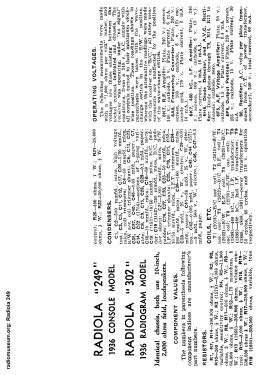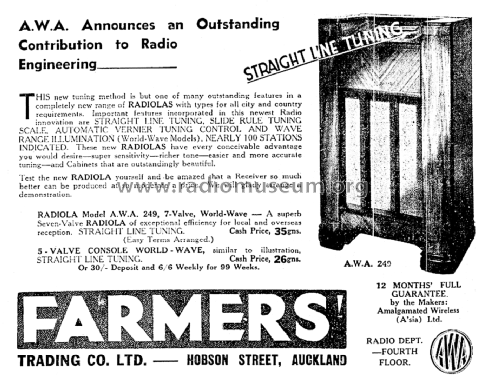- Fabricante / Marca
- Amalgamated Wireless Australasia (NZ) Ltd. (AWA); Wellington
- Año
- 1936
- Categoría
- Radio - o Sintonizador pasado WW2
- Radiomuseum.org ID
- 350113
Haga clic en la miniatura esquemática para solicitarlo como documento gratuito.
- Numero de valvulas
- 7
- Principio principal
- Superheterodino con paso previo de RF; ZF/IF 460 kHz; 2 Etapas de AF
- Número de circuitos sintonía
- 7 Circuíto(s) AM
- Gama de ondas
- OM y OC
- Tensión de funcionamiento
- Red: Corriente alterna (CA, Inglés = AC) / 50 Hz, 200-230; 230-260 Volt
- Altavoz
- Altavoz electrodinámico (bobina de campo) / Ø 10 inch = 25.4 cm
- Material
- Madera
- de Radiomuseum.org
- Modelo: Radiola 249 - Amalgamated Wireless
- Forma
- Consola en general
- Anotaciones
-
RADIOLA Model A.W.A. 249, 7-Valve, World-Wave... A superb Seven-Valve RADIOLA of exceptional efficiency for local and overseas reception. STRAIGHT LINE TUNING. Cash Price, 35gns.
A.W.A. Announces an Outstanding Contribution to Radio Engineering. STRAIGHT LINE TUNING...THIS new tuning method is but one of many outstanding features in a completely new range of RADIOLAS with types for all city and country requirements. Important features incorporated in this newest Radio innovation are STRAIGHT LINE TUNING, SLIDE RULE TUNING SCALE. AUTOMATIC VERNIER TUNING CONTROL AND WAVE RANGE ILLUMINATION (World-Wave Models), NEARLY 100 STATIONS INDICATED. These new RADIOLAS have every conceivable advantage you would desire...super sensitivity...richer tone...easier and more accurate tuning...and Cabinets that are outstandingly beautiful. Test the new RADIOLA yourself and be amazed that a Receiver so much better can be produced at so moderate a price. We will gladly arrange a demonstration.
Made in Australia
See also the Australian model Radiola 249.
- Precio durante el primer año
- 35.00 NZ Guineas
- Mencionado en
- -- Original prospect or advert (New Zealand Herald 16 April 1936 Page 16)
- Autor
- Modelo creado por Brian Stevens. Ver en "Modificar Ficha" los participantes posteriores.
- Otros modelos
-
Donde encontrará 42 modelos, 39 con imágenes y 27 con esquemas.
Ir al listado general de Amalgamated Wireless Australasia (NZ) Ltd. (AWA); Wellington


